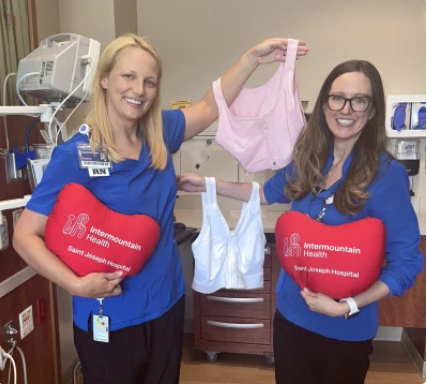How did a $60 bra save 274 hospital days and $751,000?
By Patricia Billinger, Intermountain Health Regional Director of Communications
Lauren Zobec, RN, and Sarah Duart, RN, knew there was a problem. The CV nurses at Saint Joseph had noticed a string of open-heart surgery patients being readmitted for both sternal and pressure wounds.
They identified a common thread through the cases: All involved patients with large breasts.
“After patients with larger breasts have open heart surgery, there is a big risk of pull on the sternal incision, especially when they're lying down sleeping at night,” Zobec explained. “If they're not wearing breast support 20-24 hours a day, the breast tissue can pull the sternum apart, pulling apart the incision.”
These sternal wounds are painful and require lengthy, extensive in-patient treatment.
“These sternal wounds are huge. They’re nasty. They take debridement, they take wound vacs, they take weeks and weeks of IV antibiotics,” she said. “So these patients are here for extended stays and they frequently have to come back multiple times.”
One patient even confided to the pair that she wouldn’t have gone through the lifesaving surgery if she had known how painful her pressure wound would be. But that same patient also gave Zobec and Duart a clue to the culprit. She mentioned that her post-surgery recovery bra was uncomfortable and too small.
So they looked at the post-surgical bra that’s the standard across most hospitals and found it’s made of uncomfortable polyester that doesn’t breathe or stretch well. The bra’s hook-and-eye closures are difficult for people with dexterity issues and can't be opened quickly in an emergency. And the largest size is simply too small for patients with large torsos and/or breasts.
As a result, some patients weren’t wearing the bra in compliance with post-op instructions, and others who were wearing the bra were developing pressure wounds on the sides of their torsos.
Thus began the search for a better bra.
Zobec and Duart asked the Saint Joseph Clinical Research Library to perform a literature search focused on products in use to meet this need. The search turned up a hospital in the United Kingdom that had experienced similar patient issues. The hospital designed its own post-op bra and saw sternal infection rates drop by half.
“I was like, there's no way they're going to let us import bras from the UK, so, what can we find locally that has the same characteristics that would get us the same results?” Zobec said.
Through their research, they found a bra designed by a former radiation oncologist. Although it was intended for post-mastectomy surgery, the bra checked all the boxes: soft, flexible, breathable material with a Velcro front-closure and sizing up to 6X.
The new bra’s cost ($60) was comparable to the existing one, so Zobec and Duart worked with Materials Management to stock the Saint Joseph CV floor with the improved product. They also developed a patient education sheet explaining proper use for optimal recovery. Finally, they launched an improvement to pre-op: Whereas before, caregivers simply guessed at the best bra size for a patient, now they measure patients prior to surgery to ensure the best fit.
Zobec and Duart showcase fashion that supports faster healing for CV patients post-op
Saint Joseph began using the improved bra, education and pre-op process in September 2023 and since then zero women who had open-heart surgery have been readmitted for sternum or pressure wounds.
Comparing the outcomes to last year, the old-bra-busting duo estimate this change has eliminated 274 additional hospital days due to wounds and has saved about $751,000.
“Overall feedback from patients has been very positive. Impact on subsequent issues is quite astounding!” said Jess Joymon, MD, Thoracic & Cardiac Surgery.
One patient said, “When they told me I had to wear a bra post-op – I was a little disappointed as it did not sound comfortable. I woke up and had this pink bra on. Honestly, I didn’t even know I was wearing one! It was so comfortable.”
Surprisingly, the research didn’t indicate that many hospitals in the US, if any, have tried on this solution for CV patients.
“I've been a CV nurse for 18 years, and we've always had just that one bra that looks like it hasn’t changed since the 70s. I think it's just the product we had and nobody ever thought about doing anything differently,” Zobec said.
Changing to a better product is a matter of patient quality, experience and equity. “This was a very painful problem being experienced by women, and in particular by women with larger bodies,” Duart said.
Zobec is passionate about spreading the news of this better fit as far and wide as possible. “It’s the patients. It’s the women. We’re here to help them and I want to get this everywhere because I think it’s important and it’s the right thing to do for these women,” she said.

